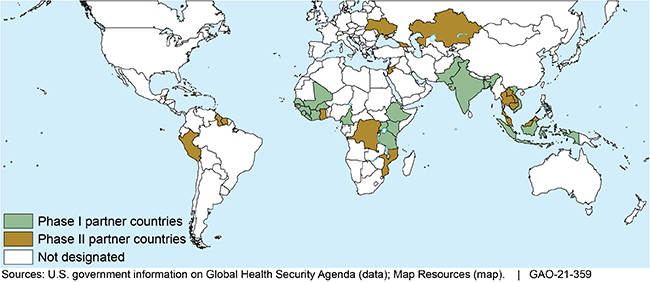Global Health Security: USAID and CDC Funding, Activities, and Assessments of Countries' Capacities to Address Infectious Disease Threats before COVID-19 Onset
Fast Facts
Pour la version française de cette page, voir GAO-21-484.
USAID and CDC have invested in global health security, helping other countries build capacity to handle infectious diseases. In the 5 years before COVID-19, the agencies spent about $1 billion in over 30 countries.
The agencies assessed several capacity indicators—e.g., the strength of a country's diagnostic laboratory system—in 17 high-priority countries. In most areas, the capacity to fight infectious diseases had remained stable or increased since 2016 and 2017.
The agencies also found challenges to building capacity—e.g., a lack of trained personnel to implement health policy. Many of these challenges are outside the U.S. government's control.
U.S. Government-Supported Global Health Security Agenda Partner Countries, FYs 2015-2019

Highlights
Pour la version française de cette page, voir GAO-21-484.
What GAO Found
As of March 31, 2020, the U.S. Agency for International Development (USAID) and the Centers for Disease Control and Prevention (CDC) had obligated a combined total of more than $1.2 billion and disbursed about $1 billion for global health security (GHS) activities, using funds appropriated in fiscal years 2015 through 2019. USAID and CDC supported activities to help build countries' capacities in 11 technical areas related to addressing infectious disease threats. The obligated funding supported GHS activities in at least 34 countries, including 25 identified as Global Health Security Agenda (GHSA) partner countries.
U.S.-Supported Activities in Ethiopia to Strengthen Global Health Security

U.S. officials' assessments of 17 GHSA partner countries' capacities to address infectious disease threats showed that at the end of fiscal year 2019, most countries had some capacity in each of the 11 technical areas but faced various challenges. U.S. interagency country teams produce biannual capacity assessments that USAID and CDC headquarters officials use to track the countries' progress. According to fiscal year 2019 assessment reports, 14 countries had developed or demonstrated capacity in most technical areas. In addition, the reports showed the majority of capacities in each country had remained stable or increased since 2016 and 2017. The technical area antimicrobial resistance showed the largest numbers of capacity increases—for example, in the development of surveillance systems. GAO's analysis of the progress reports found the most common challenges to developing GHS capacity were weaknesses in government institutions, constrained resources, and insufficient human capital. According to agency officials, some challenges can be overcome with additional U.S. government funding, technical support, or diplomatic efforts, but many other challenges remain outside the U.S. government's control.
This is a public version of a sensitive report that GAO issued in February 2021. Information that USAID and CDC deemed sensitive has been omitted.
Why GAO Did This Study
The outbreak of Coronavirus Disease 2019 (COVID-19) in December 2019 demonstrated that infectious diseases can lead to catastrophic loss of life and sustained damage to the global economy. USAID and CDC have led U.S. efforts to strengthen GHS—that is, global capacity to prepare for, detect, and respond to infectious disease threats and to reduce or prevent their spread across borders. These efforts include work related to the multilateral GHSA initiative, which aims to accelerate progress toward compliance with international health regulations and other agreements.
House Report 114-693 contained a provision for GAO to review the use of GHS funds. In this report, GAO examines, for the 5 fiscal years before the onset of the COVID-19 pandemic, (1) the status of USAID's and CDC's GHS funding and activities and (2) U.S. agencies' assessments, at the end of fiscal year 2019, of GHSA partner countries' capacities to address infectious disease threats and of challenges these countries faced in building capacity.
GAO analyzed agency, interagency, and international organization documents. GAO also interviewed agency officials in Washington, D.C., and Atlanta, Georgia, and in Ethiopia, Indonesia, Senegal, and Vietnam. GAO selected these four countries on the basis of factors such as the presence of staff from multiple U.S. agencies. In addition, GAO analyzed interagency assessments of countries' capacities to address infectious disease threats in fiscal year 2019 and compared them with baseline assessments from 2016 and 2017.
For more information, contact David Gootnick at (202) 512-3149 or gootnickd@gao.gov.
